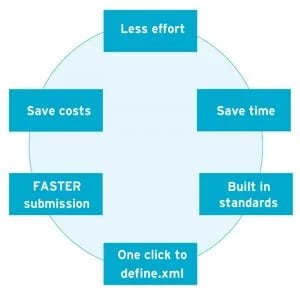Define-XML is the metadata that describes the content and formatting of submission datasets and the case report tabulation data. It’s needed to help reviewers understand the data they are reviewing.
It’s based on the CDISC ODM standard and is a key requirement for electronic submissions to the FDA and PDMA.
Creating a Define-XML requires a lot of programming expertise. It takes a lot of time. That’s why it’s so important to make the process as quick and easy as possible.
Download Now: Free guide on how to overcome problems with Define-XML
And, if you’re interested, we’ve written blogs on How to Describe Multiple Origins for a Value in Define-XML 2 and Using Define-XML for Dataset Design.
Can our Visual Define-XML Editor make it quick and easy?
Yes! There’s no manual work. And there’s no programming involved. So, that means no XML or SAS expertise is needed.
All you have to do is click a button to get your Define-XML. Or another button click gives your Define-XML as PDF or Define-HTML.
Is it really that easy?
Yes and no… It really is just a click of a button to get your Define files. But there’s a bit of setup to do beforehand:

First of all, get your metadata into ryze. You can import and convert SAS XPT files and old legacy files. Or you can import spreadsheets for conversion.
Next, build your study. You can import existing standards to do this making it a quick and easy process. Or, import content directly into ryze from the Medidata Rave EDC or the Oracle InForm EDC (or other leading EDCs).
Define your datasets using the built-in SDTM and ADaM templates. Check to see if all the validation rules are met. And fix anything that’s not quite right.
|
All you need to do is click a button and you have your submission ready Define-XML! As an added bonus, you can reuse your datasets and mappings. They’ve already been tried and tested, so next time, setup is even quicker and easier! |
What else can help?
The CDISC Define-XML standard is built into our study automation platform. So there’s no need to worry about not sticking to the rules. You can use the validation tools to see if there’s anything wrong with your datasets before generating your Define-XML.
If you design your forms in our product, you can predict your define.xml. And, it’s really accurate. This makes designing your datasets much easier. And much quicker!
SDTM, ADaM and SEND templates to help you build your datasets. It easy to add domains and variables. And there are various versions to choose from.
What about validation?
Our validation tool lets you check your datasets against rules for standards. Any problems are highlighted and you can see exactly where to fix them. This means you can validate your study throughout the process. Then when it’s time for submission, everything’s correct!
It’s quick and easy to see your clinical metadata. You can preview a full definition of your define with links to annotated CRFs and submission datasets. And visualize your Define in PDF format with links to the annotated CRF.
What are the benefits of using ryze Visual Define-XML Editor?

No programming means no SAS expertise required. Less time spent on programming means you save money. And that’s a lot less effort required!
The Define-XML standard is built-in. So you don’t have to worry about non-compliance. And our platform complies with FDA and NCI standards too.
The validation tool lets you check your datasets are correct. If there are any issues, you can easily see where to find and fix them.
It’s just one button click to generate Define-XML, Define-PDF, and Define-HTML. And that’s about as stress-free as you can get!
So all this boils down to you being able to submit your studies much faster!
Are you in good hands?
We’re biased, but we think so! We’ve been in the business for 20 years. In that time, we’ve really listened to our customers about what they want. And we’ve become experts in CDISC standards.
As members of the CDISC development team, we’ve been involved in developing Define-XML 2.0. And, don’t forget the upcoming Define-XML 2.1!
Being so involved means our platform is always up to date. There’s no need to worry about not meeting Define standards in the future. But that doesn’t mean we forget about previous versions. You can continue to create your define.xml in whatever version you need.
Request a no-strings software demo here. Let us know what you need and we’ll show you how we can help.
And, you won’t be left high n’ dry…
It’s a big commitment to start using new software and technologies. And there’s always an uncomfortable learning curve involved. We understand this. We’ll continue to support you and your teams whenever you need a hand.
Our Professional Services team is here to help convert different data formats into define.xml for you. And they’ll work their magic to make it valid. You don’t need to worry.
Or we can help you design your forms and annotations. Get in touch and let us know how we can help.








